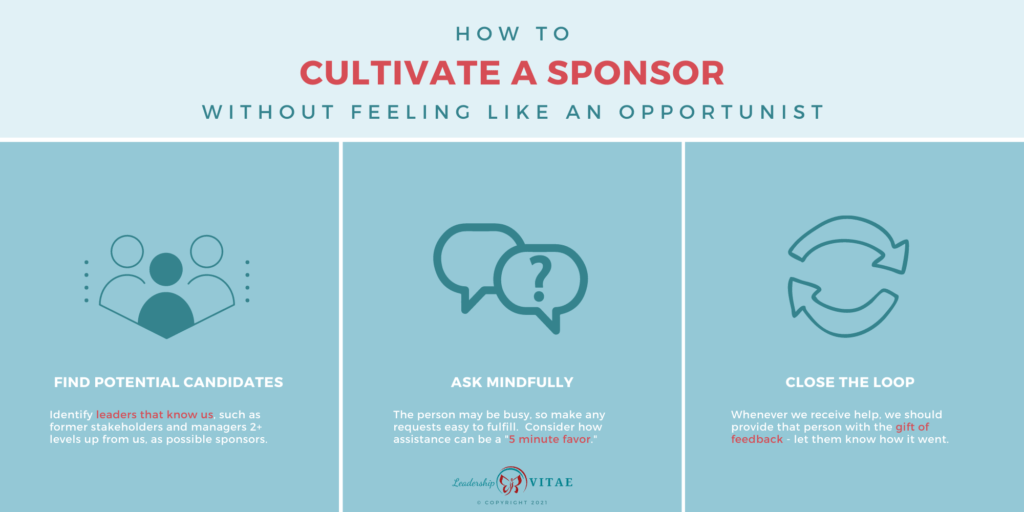
Since the release of Lean In, women have been hearing about the importance of a sponsor to help us move forward in our careers.
As a reminder, a sponsor is a senior member of an organization that advocates for us when we are not in the room. Sounds ideal, doesn’t it? Someone to help pave the way for our next opportunities?
Knowing what a sponsor IS doesn’t seem to be the challenge. For most women, however, HOW to get one seems to be problematic.
While this is not true of all women, studies show that women tend to be less self-promoting. There is also the need to balance displaying confidence with being nice, at risk of being seen as over-confident and aggressive.
So, how do we cultivate a sponsorship without feeling slimy or being perceived as arrogant?
It’s a fine line that can be managed by investing in one key skill: relationship building.
The secret that’s not a secret
We all suspect that there are jobs that are never posted. Roles that we never hear about before someone is named to fill them. Conversations that go on behind closed doors, even if the roles are public.
I can’t speak about all companies, but the executives I’ve spoken with and experiences I’ve had point to all answers being yes.
More and more companies are fighting this trend and providing visibility and transparency into higher level positions. However, senior leaders still influence outcomes, no matter how transparent the process becomes.
Years ago, I applied for a senior level position in another area of the company. At the end of the process, the hiring manager had selected me, but he was meeting with some resistance.
The resistance wasn’t about my ability. He was a Senior Vice President and should have been able to hire whomever he wanted. There was one problem. None of the other senior leaders knew who I was. There was no one else in the room to vouch for me.
I was going to trust the process, until I had a conversation with my CIO at the time. She gave me more insight into those inner workings. Insight that would change my perspective AND the outcome.
The sponsors we don’t realize we have
My CIO and I were discussing my career and why I wanted to pursue this opportunity. She was open to helping me, but said she didn’t have the right influence for this position. But she knew who did.
She knew a leader that was a previous stakeholder of mine. The two of them had discussed me at some point and she knew he was a supporter. She encouraged me to reach out and ask for his endorsement.
I immediately rejected the idea. We hadn’t spoken in two years. Any request would come across as opportunistic and “slimy” in my mind.
She debunked the myth. Leaders at that level don’t have time to be actively engaged with us with any regularity. However, if we’ve done good work for them in the past, they are predisposed to help us. They want to help, but often don’t know how and when we need it.
She encouraged me to get over my hesitation and reach out. Sure enough, he responded to my email in about 15 seconds – “Who do I need to talk to?”
It took a few days, but I received the job offer and the rest is history. Turns out, we may have a lot of potential sponsors who would be willing to advocate for us, but there’s a catch. It matters who we ask, how we ask, and that we close the loop.

Step 1: Find potential sponsors
In order for sponsors to feel comfortable putting us forward, they want to know we will do well. They are expending political capital on our behalf, so there is reputational risk if we aren’t a good fit.
When pursuing a role or next stage in your career, consider who knows your work. They may be your former manager’s manager, or stakeholders on projects you’ve worked on. The key is to find leaders who are likely to have heard of you and know your work.
List out all of the leaders (aim for 2+ levels up from you) that you’ve engaged with. Pay particular focus on those that are in the area of the company you want to work for, or who have relationships with leaders that are.
At any point, if you are not sure who could be a potential sponsor, try asking a trusted mentor. Particularly if you have one that is in a leadership position that can help guide you. In my case, my CIO helped me hone in on the exact person that could help.
Step 2: Mind how you ask
When you reach out to a potential sponsor, keep in mind they are busy and know a lot of people. My CIO indicated that she gets requests for help regularly, but the ones she WANTS to help are those that have delivered for her in the past and those she’s most suited to help given her role.
Trying to get on the individual’s calendar may be disruptive and more time than they have to give. Instead, she encouraged email, as it’s essentially a “5 minute favor” that anyone would be more prone to do because it’s quick and easy, without impacting their day.
The email should include a few key elements:
- Opening pleasantry, without going overboard. In my case I indicated that I had heard about his new position, hoped he was moving the organization forward the way he desired, and that he and his family were doing well with the change.
- Outline the opportunity and why you think you’re a fit. I summarized the position, where in the organization it fit, and highlighted skills he would be familiar with that made me suited to the role.
- Include the ask. I asked if he would be willing to reach out to the hiring manager to endorse me for the position.
It doesn’t need to be long, and is better if it is not. A “5 minute favor” includes the time to read the email AND provide the help you’re requesting.
Step 3: Close the loop
At this point, it may still feel opportunistic to ask for help from someone you haven’t spoken to in (potentially) years. Here’s where you can clear your conscience.
No matter how things end up, reach back to your potential sponsor and let him or her know how it went.
If you got the job, send a thank you note for their help. If you didn’t, let them know that too, and that you’d be interested if they hear of anything similar in the future. You now have someone poised to advocate for you when you’re not in the room.
The circling back is the most critical step. Feedback I received from my CIO, and other subsequent executives, is that they often don’t know whether their help worked. They never get the good feeling that comes from helping others because they don’t hear back.
Please tell them. Sponsors are people too. They get a good feeling by helping others.
If we tell them how they helped, or didn’t, we are doing our part to give back to the relationship. We are giving what we can – it is as much a gift to a sponsor as their endorsement is to us.
If we do not circle back, then we are behaving in an opportunistic way. They are unlikely to help us again if we ask and we are not cultivating the relationship.
Bringing it together
Next time you are pursuing an opportunity – or you’re looking to make a big change without a specific role in mind – and you think sponsorship might help you, consider these steps.
- Make a list of who you’ve helped in the organization
- Mind how you ask for help, thinking “5 minute favor”
- Close the circle to build the relationship
After becoming an executive myself, I can attest to my willingness to help others who have done good work, the ease of a “5 minute favor,” and the wonderful feeling of knowing I’ve been able to help.
Learning this approach to cultivating sponsorship was a gift from one of my mentors. One I am now happy to say I can give back, and share with others to increase the giving.
Are there other actions you’ve taken or strategies you’ve applied to build sponsorship in an organization? Other advice you’d give? I’d appreciate if you’d contribute additional thoughts or ideas in the comments.








